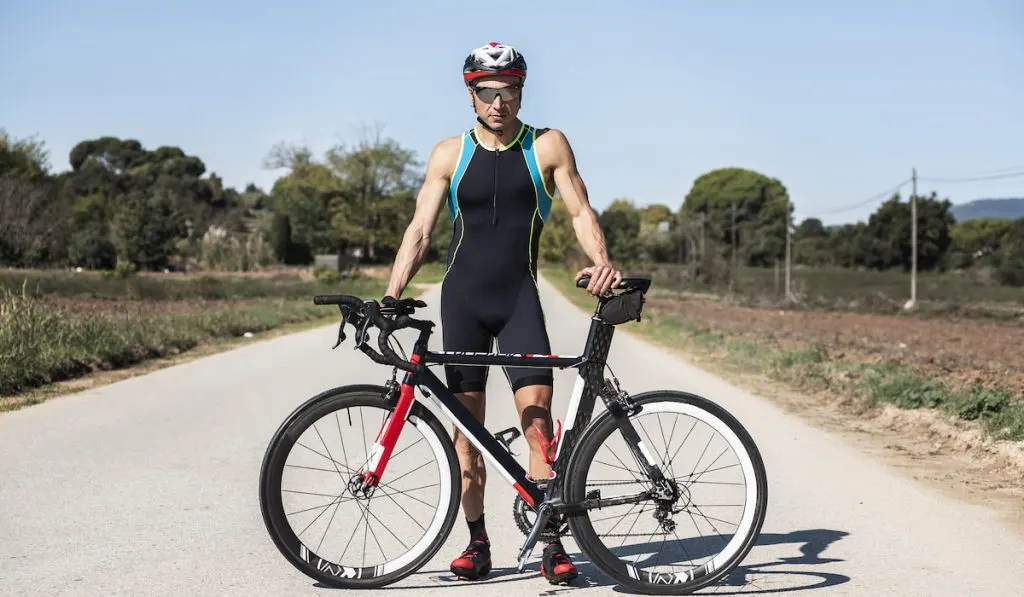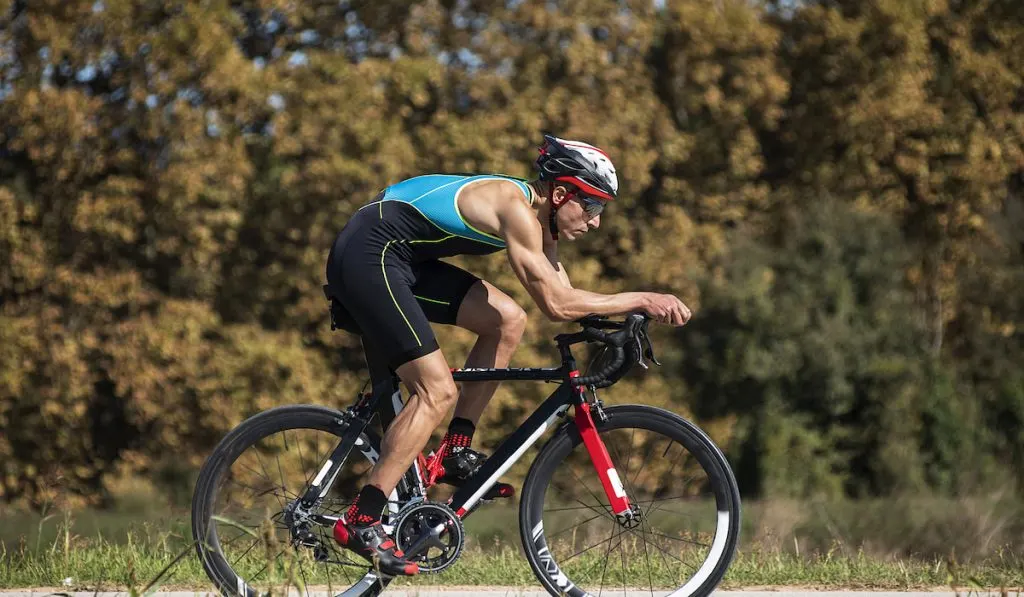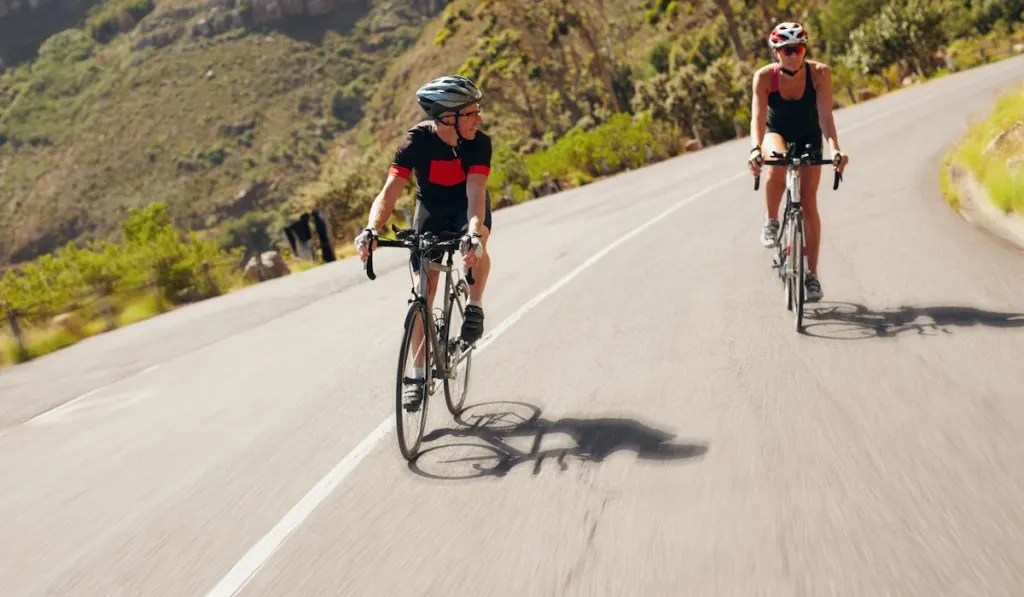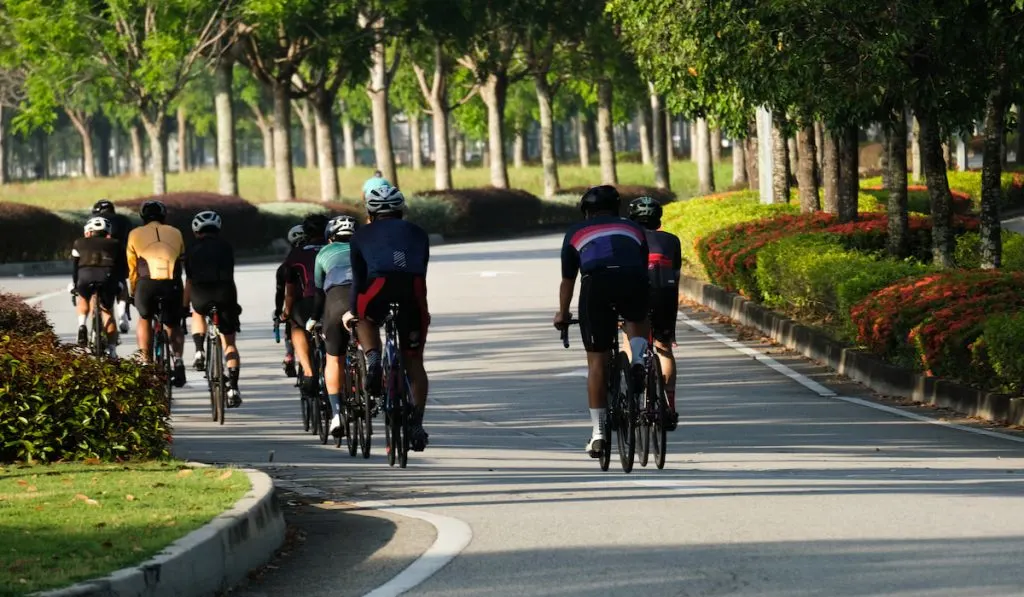A triathlon is a multi-event sport where athletes swim, bike, and run, in that order. Unlike other sporting events where only skilled professionals can compete, a triathlon provides an opportunity for everyone to have a go.
This is possible thanks to various categories of distances defined by the World Triathlon, which is the international governing body for triathlon events across the globe.
Five different competing levels have been specified for the competing athletes. These levels have unique distance limits that all the respective participants have to follow.

For bikers, these limits range from less than 20km (12.42 miles) to more than 180km (111.8 miles).
In this article, we’ll be answering a lot of frequently asked questions relating to the biking portion of a triathlon race. We’ll be discussing the rules relating to this event and how it connects with the other two events of swimming and running.
Walking A Bicycle
Walking a bicycle is not allowed during the biking event of a triathlon. There is only one exception to this rule: you can only walk your bike if it breaks down and you can no longer ride it.
Here you must know another rule regarding the breakdown of your bike, which is that you cannot leave your bike by the roadside and simply run towards the next transition line.
You only have two options. You can either wait for the repair team to fix your bike or you can walk it to the next transition line.
An alternate solution to this problem is that you can repair your bike yourself. You can carry the tools to fix your bike if you have the skill to do it quickly.

Training For Biking
The race route for the biking event is usually a busy road. You have to ride in a distinct lane specified by the triathlon authority.
As you’ll be riding on a special racing bike, it is important for you to get used to the bending posture while riding.
You must have the necessary skill and experience of riding these bicycles on a busy road. Therefore, training for the biking event in the triathlon is necessary for whatever distance you choose to ride.
Bikes Selection
Most triathlon riders use special bicycles for the biking event in the triathlon. These bicycles have unique design elements that help them in gaining a higher speed than most normal bicycles.
However, the selection of the bike is a personal choice and not a mandatory requirement.
Dress and Safety Equipment
The option of dressing for the triathlon race is a personal choice.
As racers have to go through three different events in a single go, they choose to wear custom outfits that allow them to swim, ride, and run without the need for changing them.
This is done in order to save the transition time.
Wearing a helmet and buckling up the chin strap is a requirement that all riders must fulfill.
You must put on the helmet before mounting the bicycle and must not remove it while you ride. Once you reach the transition area and dismount from the bike, only then can you take off your helmet.
*The helmet you choose to wear in a triathlon bike riding race must be approved by the US Consumer Product Safety Commission (CPSC).
Riding and Over-taking
While riding the bike in the triathlon race, all athletes must keep a distance of at least 22 feet between them. If you come closer to the rider in front of you, you’ll have to overtake them within 15 seconds.

If you cannot overtake in the given timeframe, you’ll have to drop your speed to maintain the defined distance.
But if you successfully overtake the rider, they’ll have to perform the same process and drop their speed.
Many riders face different time penalties due to a lack of understanding of this rule, therefore, you must practice and develop distance-keeping and overtaking skills to avoid such penalties.
Electric Accessories
As a rider, you are allowed to use a few essential electrical types of equipment such as watches, heart rate monitors, power meters, and the like.
However, you cannot use audio devices, including both input and output devices.
You can neither talk nor listen to someone else during a race.
Transition Periods
You cannot ride a bicycle in the transition area.
Once you come near the starting point of this area, you must descend from your bike and walk to the finishing point.
You must familiarise yourself with the transition rules. Most riders face time penalties due to a lack of understanding of these rules.
Tools and Trash
As an athlete, you’ll be carrying your gear which includes all tools, food, and energy drinks.
The triathlon authority emphasizes the importance of the management of your accompanying gear. You cannot simply throw away your trash after you utilize it.
There are specific points where you can dispose of your unwanted materials. If you fail to comply with this rule, you’ll have to face a possible penalty.
Resting, Eating, and Drinking
You must carefully choose the right distance for your triathlon racing experience especially if it’s your first participation in this event.
Resting, eating and drinking are important elements of this race but not commonly practiced by most of us.
Most of us can ride, run, and swim, but eating and drinking without any stoppage during all these events is unique to events such as triathlon.
Therefore, when you practice for such a race, try out the foods and drinks that quickly produce carbohydrates in your body.
Other Important Tips For Riders:
Competing in any sport is difficult at the beginning due to a lack of experience. You’ll gradually improve your performance after you compete in multiple triathlon events.

Following are a few tips that will provide you a head start in your career as a triathlete.
- Join a riders’ club and learn from experienced riders.
- Explore shorter tracks before you move on to lengthy ones.
- Choose your bike carefully. Not all bikes suit all riders. Instead of finding the best one, look for the right one.
- Choose the most efficient and effective riding position. Make sure you’re not too uncomfortable while riding.
- Train in real race conditions.
- Record your progress.
- Learn how to repair your bike quickly.
- Monitor your physical condition.
- Take care of your diet and nutrition. Make sure that you have sufficient calorie intakes to fulfill your energy needs.
- Learn how to manage your stuff while racing.
- Remember all the rules and plan to follow them.
- Choose appropriate gadgets. Don’t carry unnecessary items in a triathlon.
- Learn how to use your gear more effectively.
- Double-check your gear before the race.
- Don’t expect sudden improvement in your riding after some training. Allow yourself to grow and improve organically.
- Build your emotional strength and intelligence.
- Enjoy the entire process.
Resources:
- https://tritomakeadifference.org/race-details/race-rules/
- https://www.triathlon.org.au/State_Associations/NSW/Getting_Started/What_is_Triathlon_.htm
- https://trainright.com/the-5-most-common-triathlon-rule-violations-and-how-to-avoid-them/
- https://www.triathlon.org/uploads/docs/World_Triathlon_Sport_Competition_Rules_2020_201811253.pdf
